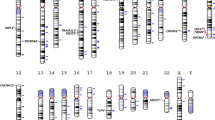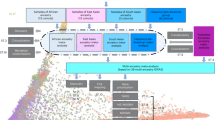Abstract
The Schizophrenia Psychiatric Genome-Wide Association Study Consortium (PGC) highlighted 81 single-nucleotide polymorphisms (SNPs) with moderate evidence for association to schizophrenia. After follow-up in independent samples, seven loci attained genome-wide significance (GWS), but multi-locus tests suggested some SNPs that did not do so represented true associations. We tested 78 of the 81 SNPs in 2640 individuals with a clinical diagnosis of schizophrenia attending a clozapine clinic (CLOZUK), 2504 cases with a research diagnosis of bipolar disorder, and 2878 controls. In CLOZUK, we obtained significant replication to the PGC-associated allele for no fewer than 37 (47%) of the SNPs, including many prior GWS major histocompatibility complex (MHC) SNPs as well as 3/6 non-MHC SNPs for which we had data that were reported as GWS by the PGC. After combining the new schizophrenia data with those of the PGC, variants at three loci (ITIH3/4, CACNA1C and SDCCAG8) that had not previously been GWS in schizophrenia attained that level of support. In bipolar disorder, we also obtained significant evidence for association for 21% of the alleles that had been associated with schizophrenia in the PGC. Our study independently confirms association to three loci previously reported to be GWS in schizophrenia, and identifies the first GWS evidence in schizophrenia for a further three loci. Given the number of independent replications and the power of our sample, we estimate 98% (confidence interval (CI) 78–100%) of the original set of 78 SNPs represent true associations. We also provide strong evidence for overlap in genetic risk between schizophrenia and bipolar disorder.
This is a preview of subscription content, access via your institution
Access options
Subscribe to this journal
Receive 12 print issues and online access
$259.00 per year
only $21.58 per issue
Buy this article
- Purchase on Springer Link
- Instant access to full article PDF
Prices may be subject to local taxes which are calculated during checkout
Similar content being viewed by others
References
McGrath JJ . The surprisingly rich contours of schizophrenia epidemiology. Arch Gen Psychiatry 2007; 64: 14–16.
Harrison PJ . The neuropathology of schizophrenia. A critical review of the data and their interpretation. Brain 1999; 122 (Part 4): 593–624.
Cardno AG, Gottesman II . Twin studies of schizophrenia: from bow-and-arrow concordances to star wars Mx and functional genomics. Am J Med Genet 2000; 97: 12–17.
Sullivan PF, Kendler KS, Neale MC . Schizophrenia as a complex trait: evidence from a meta-analysis of twin studies. Arch Gen Psychiatry 2003; 60: 1187–1192.
Ripke S, Sanders AR, Kendler KS, Levinson DF, Sklar P, Holmans PA et al. Genome-wide association study identifies five new schizophrenia loci. Nat Genet 2011; 43: 969–976.
Purcell SM, Wray NR, Stone JL, Visscher PM, O'Donovan MC, Sullivan PF et al. Common polygenic variation contributes to risk of schizophrenia and bipolar disorder. Nature 2009; 460: 748–752.
O'Donovan MC, Craddock N, Norton N, Williams H, Peirce T, Moskvina V et al. Identification of loci associated with schizophrenia by genome-wide association and follow-up. Nat Genet 2008; 40: 1053–1055.
Stefansson H, Ophoff RA, Steinberg S, Andreassen OA, Cichon S, Rujescu D et al. Common variants conferring risk of schizophrenia. Nature 2009; 460: 744–747.
Shi J, Levinson DF, Duan J, Sanders AR, Zheng Y, Pe'er I et al. Common variants on chromosome 6p22.1 are associated with schizophrenia. Nature 2009; 460: 753–757.
Rietschel M, Mattheisen M, Degenhardt F, Kahn RS, Linszen DH, Os JV et al. Association between genetic variation in a region on chromosome 11 and schizophrenia in large samples from Europe. Mol Psychiatry; advance online publication, 12 July 2011.
Sebat J, Levy DL, McCarthy SE . Rare structural variants in schizophrenia: one disorder, multiple mutations; one mutation, multiple disorders. Trends Genet 2009; 25: 528–535.
Kirov G, Pocklington AJ, Holmans P, Ivanov D, Ikeda M, Ruderfer D et al. De novo CNV analysis implicates specific abnormalities of postsynaptic signalling complexes in the pathogenesis of schizophrenia. Mol Psychiatry 2012; 17: 142–153.
Gottesman I . Schizophrenia Genesis: The Origins of Madness. WH Freeman: New York, 1991.
Ekholm B, Ekholm A, Adolfsson R, Vares M, Osby U, Sedvall GC et al. Evaluation of diagnostic procedures in Swedish patients with schizophrenia and related psychoses. Nord J Psychiatry 2005; 59: 457–464.
Jakobsen KD, Frederiksen JN, Hansen T, Jansson LB, Parnas J, Werge T . Reliability of clinical ICD-10 schizophrenia diagnoses. Nord J Psychiatry 2005; 59: 209–212.
Coentre R, Blanco P, Fontes S, Power P . Initial diagnosis and treatment in first-episode psychosis: can an operationalized diagnostic classification system enhance treating clinicians' diagnosis and the treatment chosen? Early Interv Psychiatry 2011; 5: 132–139.
Strange A, Riley BP, Spencer CCA, Morris DW, Brinen M, O'Dushlaine CT et al. Genome-wide association study implicates HLA-C*01:02 as a risk factor at the MHC locus in schizophrenia. Biol Psychiatry 2012 (in press).
Wellcome Trust Case Control Consortium. Genome-wide association study of 14 000 cases of seven common diseases and 3000 shared controls. Nature 2007; 447: 661–678.
Steinberg S, de Jong S, Andreassen OA, Werge T, Borglum AD, Mors O et al. Common variants at VRK2 and TCF4 conferring risk of schizophrenia. Hum Mol Genet 2011; 20: 4076–4081.
Williams HJ, Craddock N, Russo G, Hamshere ML, Moskvina V, Dwyer S et al. Most genome-wide significant susceptibility loci for schizophrenia and bipolar disorder reported to date cross-traditional diagnostic boundaries. Hum Mol Genet 2011; 20: 387–391.
Ferreira MA, O'Donovan MC, Meng YA, Jones IR, Ruderfer DM, Jones L et al. Collaborative genome-wide association analysis supports a role for ANK3 and CACNA1C in bipolar disorder. Nat Genet 2008; 40: 1056–1058.
McMahon FJ, Akula N, Schulze TG, Muglia P, Tozzi F, Detera-Wadleigh SD et al. Meta-analysis of genome-wide association data identifies a risk locus for major mood disorders on 3p21.1. Nat Genet 2010; 42: 128–131.
Sklar P, Ripke S, Scott LJ, Andreassen OA, Cichon S, Craddock N et al. Large-scale genome-wide association analysis of bipolar disorder identifies a new susceptibility locus near ODZ4. Nat Genet 2011; 43: 977–983.
Otto EA, Hurd TW, Airik R, Chaki M, Zhou W, Stoetzel C et al. Candidate exome capture identifies mutation of SDCCAG8 as the cause of a retinal-renal ciliopathy. Nat Genet 2010; 42: 840–850.
Hildebrandt F, Attanasio M, Otto E . Nephronophthisis: disease mechanisms of a ciliopathy. J Am Soc Nephrol 2009; 20: 23–35.
Ingason A, Giegling I, Cichon S, Hansen T, Rasmussen HB, Nielsen J et al. A large replication study and meta-analysis in European samples provides further support for association of AHI1 markers with schizophrenia. Hum Mol Genet 2010; 19: 1379–1386.
Moskvina V, Craddock N, Holmans P, Nikolov I, Pahwa JS, Green E et al. Gene-wide analyses of genome-wide association data sets: evidence for multiple common risk alleles for schizophrenia and bipolar disorder and for overlap in genetic risk. Mol Psychiatry 2009; 14: 252–260.
Acknowledgements
We thank the participants in this study and Novartis for their guidance and co-operation in obtaining CLOZUK. We also thank staff at The Doctor's Laboratory, in particular Lisa Levett and Andrew Levett, for help and advice regarding sample acquisition. We acknowledge Kiran Mantripragada, Lesley Bates, Catherine Bresner and Lucinda Hopkins for laboratory sample management, and Dobril Ivanov for computing support. Sample collection and analysis was supported by the following grants: Medical Research Council (MRC) Centre (G0800509) and Program Grant (G0801418), the Wellcome Trust (WT; 078901), the European Community's Seventh Framework Programme (HEALTH-F2-2010-241909 (Project EU-GEI)), the Stanley Medical Research Institute via the Stanley Center for Psychiatric Research at the Broad Institute of MIT and Harvard, and by CONTE NIMH (5P50MH066392-09). Genotyping was supported by the WT under WTCCC+ (Bipolar and controls) and WTCCC2. We thank the WTCCC2 project funded by WT (083948/Z/07/Z) for making available the control data. We acknowledge use of the British 1958 Birth Cohort DNA collection, funded by the MRC (G0000934) and the WT (068545/Z/0), the UK Blood Services collection of Common Controls (UKBS-CC collection), funded by the WT (076113/C/04/Z) and by NIHR programme grant to NHSBT (RP-PG-0310-1002).
Author information
Authors and Affiliations
Consortia
Corresponding authors
Ethics declarations
Competing interests
The authors declare no conflict of interest.
Additional information
Supplementary Information accompanies the paper on the Molecular Psychiatry website
Supplementary information
Rights and permissions
About this article
Cite this article
Hamshere, M., Walters, J., Smith, R. et al. Genome-wide significant associations in schizophrenia to ITIH3/4, CACNA1C and SDCCAG8, and extensive replication of associations reported by the Schizophrenia PGC. Mol Psychiatry 18, 708–712 (2013). https://doi.org/10.1038/mp.2012.67
Received:
Revised:
Accepted:
Published:
Issue Date:
DOI: https://doi.org/10.1038/mp.2012.67
Keywords
This article is cited by
-
Investigating the shared genetic architecture and causal relationship between pain and neuropsychiatric disorders
Human Genetics (2023)
-
Epigenome-wide meta-analysis of prenatal maternal stressful life events and newborn DNA methylation
Molecular Psychiatry (2023)
-
Enhanced long-term potentiation and impaired learning in mice lacking alternative exon 33 of CaV1.2 calcium channel
Translational Psychiatry (2022)
-
A non-invasive cancer gene detection technique using FLANN based adaptive filter
Microsystem Technologies (2021)
-
Transcriptome analysis of neural progenitor cells derived from Lowe syndrome induced pluripotent stem cells: identification of candidate genes for the neurodevelopmental and eye manifestations
Journal of Neurodevelopmental Disorders (2020)



